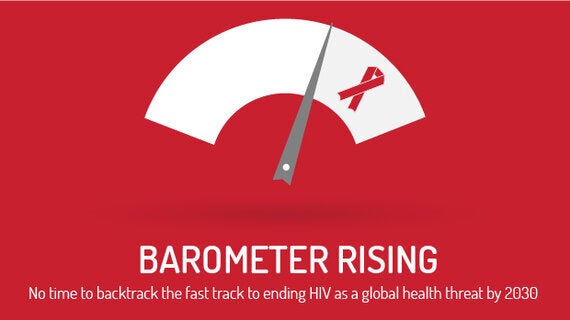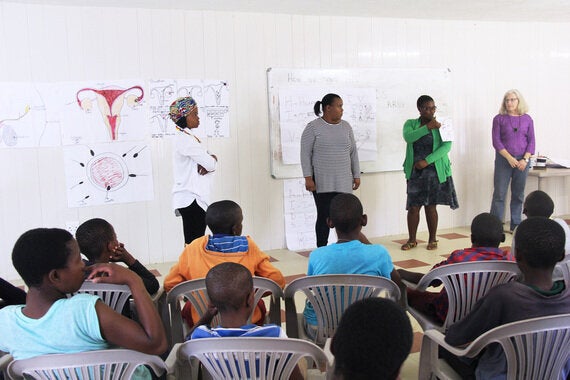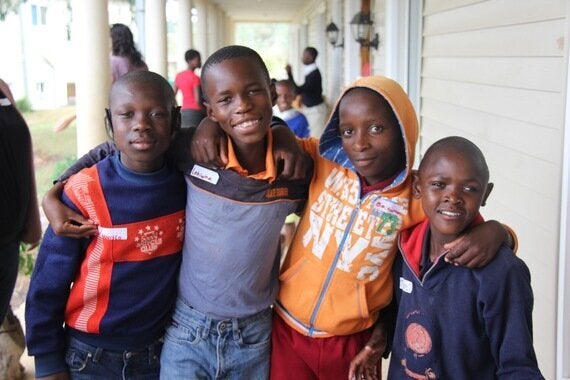
By Maddison Van Balkom and Emily Major-Girard
Events in Lesotho typically begin with a hymn or a song, followed by a prayer. At a recent sexual education workshop for deaf students hosted by Help Lesotho, the first morning's hymn started with grins from ear to ear and one small difference: the hymn was silent.
The training room -- despite being filled by 63 eager students -- was dramatically quieter than the usual cheers and singing that accompany the start of a program. The melody of the hymn was beautifully carried through sign language; a deeply moving and somewhat overwhelming experience.
Each person in the room wondered how the day would proceed, with the facilitators grappling with the challenge of presenting important information without the use of verbal communication. This silent standoff gave the hearing people in the room a moment to imagine the frustrations of a life where you cannot understand what is happening around you.
The majority of the discussions over the course of the four day workshop focused on HIV/AIDS. Lesotho, the small kingdom in the mountains of southern Africa has the second highest prevalence of HIV in the world. The percentage of Basotho infected with HIV increased from 23% in 2009 to 25% in 2014.
With one-quarter of Lesotho's population already HIV-positive, significant efforts are required to ensure that each and every person in the country has access to education and resources to prevent transmission of the virus. The most recent statistics on disabilities in Lesotho reveal that about 8,372 people are partially or totally deaf, according to the 2011 Demographic Survey Report. Each one of these people have the opportunity to protect themselves and to protect others - but only if they are included in educational HIV prevention programs.

Participants were excited and engaged during discussion during the topics covered such as Decision Making, Teenage Pregnancy, Introduction to STIs and Introduction to HIV/AIDS.
Less than twenty minutes into the first workshop, it became evident that proper sexual education is not reaching all patrons of Lesotho. In general, deaf people have lower levels of education; this increases their risk of contracting HIV as they lack the knowledge to engage in safe sex. Teachers and parents are reluctant to discuss sex with deaf youth as they assume they are not sexually active, but this is clearly not always the case.
Few health workers with knowledge of sign language and a lack of written or visual information on HIV in sign language are further barriers for those with hearing impairments. Requiring a sign language interpreter also limits the level of privacy deaf people have when accessing health services. Additionally, much information can get lost in translation. Without comprehensive knowledge of HIV transmission, Lesotho's deaf population remains vulnerable to this virus.

Participants being taught about HIV transmission through various short skits, interactive demonstrations and visuals.
In order to make progress in fighting the AIDS epidemic, UNAIDS developed a fast-track strategy known as 90-90-90. This strategy aims to meet the following objectives by 2020: 90% of people living with HIV will know their status, 90% of people diagnosed with HIV will receive antiretroviral therapy, and 90% of those receiving antiretroviral therapy experience viral suppression.
Further, the Sustainable Development Goals agreed upon by the UN in 2015 also call to end AIDS as an epidemic by 2030. Despite more than 5% of the world's population having a hearing impairment, not enough is being done to tailor HIV prevention strategies to meet the needs of deaf people.
One participant in the workshop stated this was their first time learning about HIV/AIDS, at the age of 23. This is significant given that in Lesotho, HIV prevalence rises from 4% among 15-19 year olds, to 24% among 20-24 year olds. Moreover, early sexual debut is common in Lesotho with 22.1% of girls and 7.8% of boys having sex for the first time before age 15. This gap between engaging in sex and being educated on safe sex should not be overlooked.

On the second weekend of the workshop, participants were so excited at the chance to learn more about sexual health that they arrived an hour early. This enthusiasm remained throughout the rest of the workshop!
Only two days after honouring World AIDS Day on December 1st, the world turned its attention to the International Day of Persons with Disabilities on December 3rd. Perhaps with these two days falling so close to one another the international community will recognize the value in ensuring the inclusion of people with disabilities in HIV prevention education. When talking about key populations with higher risks of contracting HIV/AIDS, women, young people, orphans, sex workers, prisoners and men who have sex with men are typically discussed.
But consider this: the World Health Organization estimated in 2012 that 360 million people worldwide have a disabling hearing loss. Of that, 36.8 million of these people live in sub-Saharan Africa. The prevalence of disabilities is higher in low income countries, where the rate of HIV/AIDS is also higher, with 24.7 million HIV positive people living in sub-Saharan Africa. There is a severe lack of data acknowledging the rates of HIV-positive disabled persons, with estimates as wide as 11% to 60%.
The few conducted studies agree that HIV prevalence among disabled persons is the same or higher compared to those without a disability. This highlights that disabled people are disproportionately more vulnerable to HIV infection. In particular, deaf people who are unable to hear oral HIV prevention messages face significant challenges in protecting themselves from HIV. If none of sub-Saharan Africa's 36.8 million deaf people receive comprehensive sexual education, reaching the 90-90-90 targets will become an impossible feat.
Though these targets are ambitious, they are achievable if we continue to create awareness and ensure that proper education reaches all citizens, especially vulnerable groups. One Help Lesotho alumni was inspired to learn sign language when she realized no deaf people in her community were receiving sexual education.
Not everyone needs to go as far as enrolling in a sign language course, but organizations and individuals working in HIV prevention can take steps to work towards the targets - starting with learning more about the needs of the deaf people in their community. A small change of actively including all key populations in proper education will lay the groundwork for an AIDS free 2030.
It is possible.
Maddison Van Balkom received her Bachelor of Social Sciences in International Development and Globalization with a Minor in Women's Studies from the University of Ottawa in 2014. Since then, Maddison completed a Postgraduate Certificate in International Development at Humber College in Toronto. During this time she completed internships with various international organizations including Plan International and GlobalMedic. Maddison will be working with Help Lesotho as a Monitoring and Evaluation Intern for 8 months until the end of April, 2017. Maddison is passionate about working towards gender equity and is excited at the opportunity to work with Help Lesotho.
Emily Major-Girard graduated from Algonquin College's Advertising and Marketing Communications Management program, then moved to Australia to receive her Bachelor's Degree in Public Relations and Communications with a Minor in Marketing. From Australia she moved to Lesotho, where she's now been for just over a month. Until the end of June, 2017 she will be working with Help Lesotho as a Communications and Support Intern. She is passionate about experiencing new cultures, and is looking forward to using her skills to help the people of Lesotho.
This blog is part of the blog series: Barometer Rising: No time to backtrack the fast track to ending HIV as a global health threat by 2030 by the Interagency Coalition on AIDS and Development (ICAD) in recognition of World AIDS Day (1 December). The series features a selection of blogs written by our member and partner organizations. Contributors share their broad range of perspectives and insight on what they think needs to be done to strengthen our HIV prevention efforts at home and abroad in order for the world to meet the ambitious target of ending AIDS as an epidemic by 2030.
Disclaimer: The views and opinions expressed in this blog series are those of the authors and do not necessarily reflect those of ICAD.
Follow HuffPost Canada Blogs on Facebook